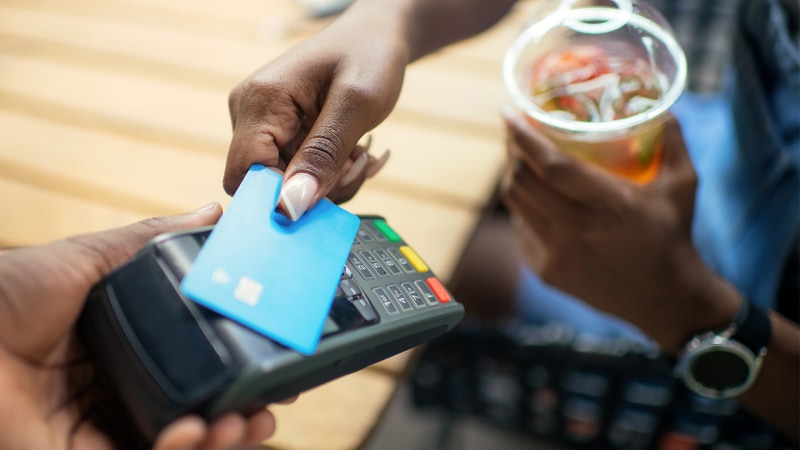What to know about contactless credit cards

Quick insights
- Contactless credit cards allow you to pay for transactions with a tap of your card at a payment terminal.
- To determine if your card is contactless, check for a symbol that looks like a Wi-Fi signal turned on its side.
- Contactless cards use a one-time code to mask your card’s information during transactions.
Contactless cards were introduced in the early 2000s to address the needs of both consumers and merchants. In 2020, contactless payments became more common as most people wanted to limit their contact with public surfaces during the COVID-19 pandemic. They continue to gain in popularity with many consumers enjoying their speed and convenience. Here are a few things you may want to know about contactless credit cards.
Understanding contactless credit cards
Contactless credit cards allow you to pay at an eligible point-of-sale terminal without needing to swipe or insert your card. Merchants may call this feature “tap to pay” or “tap and go,” but your card doesn't even have to touch the terminal during a contactless transaction.
These cards use near-field communication (NFC) and a short-wave electromagnetic signal containing your credit card information. If your card is held or waved within a few inches of the terminal, it should register. The terminal may beep, flash or display a green checkmark to signal that your payment has gone through. It’s even possible that you will not need to enter a pin or sign to complete the transaction.
How to get a contactless credit card
You may already have several contactless cards in your wallet. Credit cards typically have a symbol on the back or front of the card to indicate they are contactless. An easy way to describe the symbol is as a Wi-Fi symbol turned on its side.
If you don’t see that symbol, you may want to check with your card issuer to determine if you can get a contactless card. Many financial institutions are automatically upgrading their customers to contactless cards. Your card’s customer service should be able to confirm if you can upgrade to a contactless card.
Virtually all Chase credit cards are contactless. Most major credit card issuers are issuing contactless cards by default.
Digital wallets and contactless cards
If you have a digital wallet—like Apple Pay, Google Wallet or Samsung Pay—your card can function as a contactless card. By adding your card to the digital wallet, you’ll only need to select it as a payment option and hold your mobile phone, tablet or smartwatch near the payment terminal to complete your transaction.
The safety and security of contactless credit cards
Contactless cards can be a safe and secure way to make payments. Here are a few of their safety features:
Encryption
Each contactless card transaction is accompanied by a one-time security code that masks your payment information. This is similar to how chip technology in credit cards works. Your billing address, name and card’s security code are not transmitted with this code.
Tap-to-pay
Tapping a contactless card for transactions can help you avoid a very common form of fraud: card skimming. Swiping a card’s magnetic strip or inserting the card into a chip reader (for either payments or ATM transactions) may result in your card information being skimmed by a hidden device put in place by a bad actor. While most contactless cards still include a magnetic strip and chip, prioritizing contactless payments where possible can help reduce your chances of falling victim to this type of fraud.
Benefits of contactless cards
Contactless cards can have several benefits. They include:
- Reduced contact: You’ll have less contact with public surfaces when using a contactless card. You may not have to enter a pin number or sign a screen to complete your transaction, meaning you’ll have less contact with public spaces.
- Less wear and tear: Contactless cards are frictionless. Tapping will likely cause less wear and tear than swiping or inserting your card into a payment terminal.
- Speed: Tapping your card may be faster than other payment methods, such as cash. Transactions can take less time when you don’t have to swipe a card.
- Widely accepted: Contactless payments are widely accepted in Europe and Asia and have become widely adopted by businesses and merchants in the U.S. as well.
While contactless payments are becoming more common, you may encounter merchants that do not support this technology. You can always insert or swipe your card if it doesn’t tap. You can also choose to carry an alternate form of payment (such as cash) if you’re traveling to a location where contactless payments will likely not be supported.
In summary
Contactless credit cards are widely accepted across the U.S., Asia and Europe. They have become a popular payment option thanks to their speed and convenience. Contactless cards allow you to complete a transaction with the tap or wave of your card near a payment terminal. Most card issuers now issue contactless cards by default. To determine if your card is contactless, check for a Wi-Fi symbol turned on its side on the front or back of your card.



